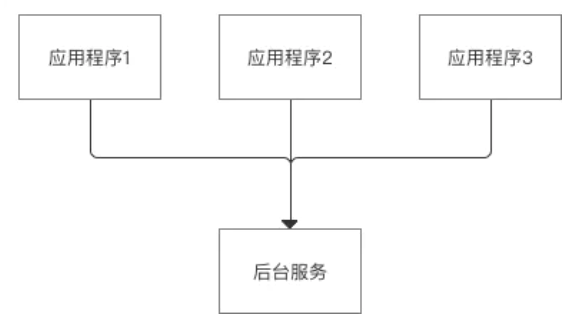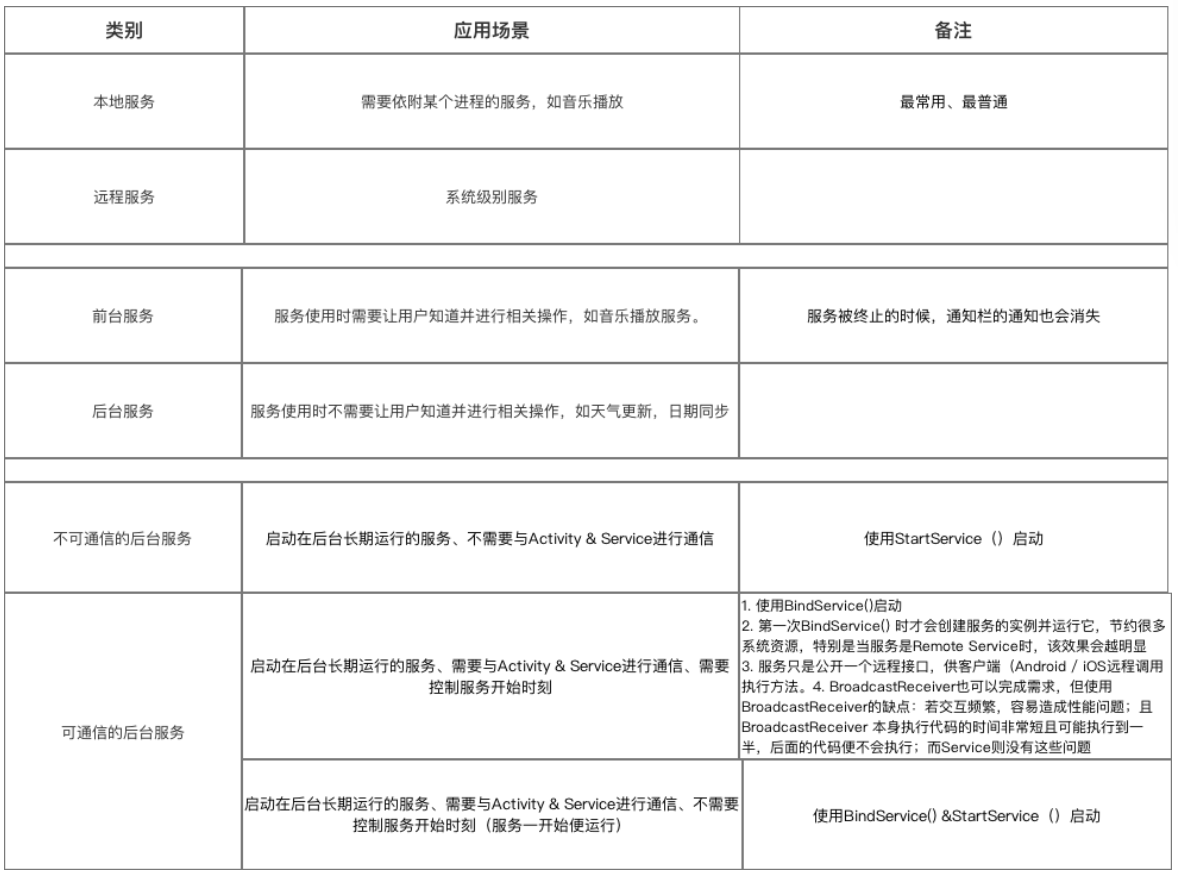IPC机制之远程服务
1. Android(本地、可通信的、前台、远程)Service使用全面介绍
2.Android:远程服务Service(含AIDL & IPC讲解)
一. Android:远程服务Service(含AIDL & IPC讲解)
本文将介绍Service其中一种常见用法:远程Service;
1. 远程服务与本地服务的区别
- 远程服务与本地服务最大的区别是:远程Service与调用者不在同一个进程里(即远程Service是运行在另外一个进程);
- 而本地服务则是与调用者运行在同一个进程里
- 二者区别的详细区别如下图:

2. 使用场景
多个应用程序共享同一个后台服务(远程服务)
即一个远程Service与多个应用程序的组件(四大组件)进行跨进程通信。使用场景:

3. 具体使用
- 为了让远程Service与多个应用程序的组件(四大组件)进行跨进程通信(IPC),需要使用AIDL
1.IPC:Inter-Process Communication,即跨进程通信
2.AIDL:Android Interface Definition Language,即Android接口定义语言;用于让某个Service与多个应用程序组件之间进行跨进程通信,从而可以实现多个应用程序共享同一个Service的功能。
4. 具体实例
实例描述:客户端远程调用服务器端的远程Service
4.1 服务器端(Service)
新建一个服务器端的工程:Service - server。先下Demo再看,效果会更好:Github_RemoteService_Server
步骤1. 新建一个AIDL文件

步骤2. 在新建AIDL文件里定义Service需要与Activity进行通信的内容(方法),并进行编译(Make Project) // 在新建的AIDL_Service1.aidl里声明需要与Activity进行通信的方法 package scut.carson_ho.demo_service; interface AIDL_Service1 { void AIDL_Service(); }

步骤3:在Service端 AIDL_Service1.Stub mBinder = new AIDL_Service1.Stub() { @Override public void AIDL_Service() { System.out.println("客户端通过AIDL与远程后台成功通信"); } }; @Override public void onCreate() { super.onCreate(); System.out.println("执行了onCreat()"); } @Override public IBinder onBind(Intent intent) { System.out.println("执行了onBind()"); //在onBind()返回继承自Binder的Stub类型的Binder,非常重要 return mBinder; } @Override public boolean onUnbind(Intent intent) { System.out.println("执行了onUnbind()"); return super.onUnbind(intent); } } 步骤4:在AndroidMainfest.xml中注册服务& 声明为远程服务 <service android:name=".MyService" android:process=":remote"//将本地服务设置成远程服务 android:exported="true" //设置可被其他进程调用 > //该Service可以响应带有scut.carson_ho.service_server.AIDL_Service1这个action的Intent。 //此处Intent的action必须写成“服务器端包名.aidl文件名” <intent-filter> <action android:name="scut.carson_ho.service_server.AIDL_Service1"/> </intent-filter> </service> 至此,服务器端(远程Service)已经完成了。
4.2 客户端(Client)
新建一个客户端的工程:Service - Client
先下Demo再看,效果会更好:Github_RemoteService_Client
步骤1:将服务端的AIDL文件所在的包复制到客户端目录下(Project/app/src/main),并进行编译
注:记得要原封不动地复制!!什么都不要改!

步骤2:在主布局文件定义“绑定服务”的按钮 步骤3:在MainActivity.java里 使用Stub.asInterface接口获取服务器的Binder; 通过Intent指定服务端的服务名称和所在包,进行Service绑定; 根据需要调用服务提供的接口方法。 public class MainActivity extends AppCompatActivity { private Button bindService; //定义aidl接口变量 private mAIDL_Service; private ServiceConnection connection = new ServiceConnection() { //重写onServiceConnected()方法和onServiceDisconnected()方法 //在Activity与Service建立关联和解除关联的时候调用 @Override public void onServiceDisconnected(ComponentName name) {} //在Activity与Service建立关联时调用 @Override public void onServiceConnected(ComponentName name, IBinder service) { //使用AIDLService1.Stub.asInterface()方法获取服务器端返回的IBinder对象 //将IBinder对象传换成了mAIDL_Service接口对象 mAIDL_Service = AIDL_Service1.Stub.asInterface(service);
//通过该对象调用在MyAIDLService.aidl文件中定义的接口方法,从而实现跨进程通信 mAIDL_Service.AIDL_Service(); } }; @Override protected void onCreate(Bundle savedInstanceState) { super.onCreate(savedInstanceState);//设置绑定服务的按钮 bindService.setOnClickListener(new View.OnClickListener() { @Override public void onClick(View v) { //通过Intent指定服务端的服务名称和所在包,与远程Service进行绑定 //参数与服务器端的action要一致,即"服务器包名.aidl接口文件名" Intent intent = new Intent("scut.carson_ho.service_server.AIDL_Service1"); //Android5.0后无法只通过隐式Intent绑定远程Service,需要通过setPackage()方法指定包名 intent.setPackage("scut.carson_ho.service_server"); //绑定服务,传入intent和ServiceConnection对象 bindService(intent, connection, Context.BIND_AUTO_CREATE); } }); } }
4.3 测试结果

从上面测试结果可以看出:
- 打印的语句分别运行在不同进程(看语句前面的包名);
- 客户端调用了服务端Service的方法
即客户端和服务端进行了跨进程通信
4.4 Demo地址
客户端:Github_RemoteService_Client
服务端:Github_RemoteService_Server
5. 总结
本文对Android组件Service中的远程Service进行了全面介绍
如果你还想了解关于Service的其他知识,请浏览以下文章:
Android:Service生命周期最全面解析
Android:(本地、可通信的、前台、远程)Service使用全面介绍
Android:远程服务Service(含AIDL & IPC讲解)
Android多线程全面解析:IntentService用法&源码

1. Service分类
1.1 Service的类型


2.具体使用解析
2.1 本地Service
这是最普通、最常用的后台服务Service。
2.1.1 使用步骤
- 步骤1:新建子类继承Service类
需重写父类的onCreate()、onStartCommand()、onDestroy()和onBind()方法
- 步骤2:构建用于启动Service的Intent对象
- 步骤3:调用startService()启动Service、调用stopService()停止服务
- 步骤4:在AndroidManifest.xml里注册Service
2.1.2 实例Demo
接下来我将用一个实例Demo进行本地Service说明,建议先下载Demo再进行阅读:(carson.ho的Github地址)Demo_for_Service
- 步骤1:新建子类继承Service类
需重写父类的onCreate()、onStartCommand()、onDestroy()和onBind()
public class MyService extends Service { //启动Service之后,就可以在onCreate()或onStartCommand()方法里去执行一些具体的逻辑 //由于这里作Demo用,所以只打印一些语句 @Override public void onCreate() { super.onCreate(); System.out.println("执行了onCreat()"); } @Override public int onStartCommand(Intent intent, int flags, int startId) { System.out.println("执行了onStartCommand()"); return super.onStartCommand(intent, flags, startId); } @Override public IBinder onBind(Intent intent) { return null; } } 步骤2:在主布局文件设置两个Button分别用于启动和停止Service 步骤3:构建Intent对象,并调用startService()启动Service、stopService停止服务 public class MainActivity extends AppCompatActivity implements View.OnClickListener { private Button startService; private Button stopService; @Override protected void onCreate(Bundle savedInstanceState) { super.onCreate(savedInstanceState); setContentView(R.layout.activity_main); startService = (Button) findViewById(R.id.startService); stopService = (Button) findViewById(R.id.stopService); startService.setOnClickListener(this); startService.setOnClickListener(this); } @Override public void onClick(View v) { switch (v.getId()) { //点击启动Service Button case R.id.startService: //构建启动服务的Intent对象 Intent startIntent = new Intent(this, MyService.class); //调用startService()方法-传入Intent对象,以此启动服务 startService(startIntent); //点击停止Service Button case R.id.stopService: //构建停止服务的Intent对象 Intent stopIntent = new Intent(this, MyService.class); //调用stopService()方法-传入Intent对象,以此停止服务 stopService(stopIntent); } } } 步骤4:在AndroidManifest.xml里注册Service <?xml version="1.0" encoding="utf-8"?> <manifest xmlns:android="http://schemas.android.com/apk/res/android" package="scut.carson_ho.demo_service"> <application android:allowBackup="true" android:icon="@mipmap/ic_launcher" android:label="@string/app_name" android:supportsRtl="true" android:theme="@style/AppTheme"> <activity android:name=".MainActivity"> <intent-filter> <action android:name="android.intent.action.MAIN" /> <category android:name="android.intent.category.LAUNCHER" /> </intent-filter> </activity> //注册Service服务 <service android:name=".MyService"> </service> </application> </manifest>
Androidmanifest里Service的常见属性说明
| 属性 | 说明 | 备注 |
|---|---|---|
| android:name | Service的类名 | |
| android:label | Service的名字 | 若不设置,默认为Service类名 |
| android:icon | Service的图标 | |
| android:permission | 申明此Service的权限 | 有提供了该权限的应用才能控制或连接此服务 |
| android:process | 表示该服务是否在另一个进程中运行(远程服务) | 不设置默认为本地服务;remote则设置成远程服务 |
| android:enabled | 系统默认启动 | true:Service 将会默认被系统启动;不设置则默认为false |
| android:exported | 该服务是否能够被其他应用程序所控制或连接 | 不设置默认此项为 false |
2.1.3 测试结果

2.1.4 Demo地址
Carson.ho的Github地址:Demo_for_Service
2.2 可通信的服务Service
- 上面介绍的Service是最基础的,但只能单机使用,即无法与Activity通信
- 接下来将在上面的基础用法上,增设“与Activity通信”的功能,即使用绑定Service服务(Binder类、bindService()、onBind()、unbindService()、onUnbind())
2.2.1 实例Demo
接下来我将用一个实例Demo进行可通信的服务Service说明
建议先下载Demo再进行阅读:(carson.ho的Github地址)Demo_for_Service
步骤1:在新建子类继承Service类,并新建一个子类继承自Binder类、写入与Activity关联需要的方法、创建实例 public class MyService extends Service { private MyBinder mBinder = new MyBinder(); @Override public void onCreate() { super.onCreate(); System.out.println("执行了onCreat()"); } @Override public int onStartCommand(Intent intent, int flags, int startId) { System.out.println("执行了onStartCommand()"); return super.onStartCommand(intent, flags, startId); } @Override public void onDestroy() { super.onDestroy(); System.out.println("执行了onDestory()"); } @Override public IBinder onBind(Intent intent) { System.out.println("执行了onBind()"); //返回实例 return mBinder; } @Override public boolean onUnbind(Intent intent) { System.out.println("执行了onUnbind()"); return super.onUnbind(intent); } //新建一个子类继承自Binder类 class MyBinder extends Binder { public void service_connect_Activity() { System.out.println("Service关联了Activity,并在Activity执行了Service的方法"); } } } 步骤2:在主布局文件再设置两个Button分别用于绑定和解绑Service // 按钮:启动服务
// 按钮:停止服务
// 按钮:绑定服务 // 按钮:解绑服务
步骤3:在Activity通过调用MyBinder类中的public方法来实现Activity与Service的联系 即实现了Activity指挥Service干什么Service就去干什么的功能 public class MainActivity extends AppCompatActivity implements View.OnClickListener { private Button startService; private Button stopService; private Button bindService; private Button unbindService; private MyService.MyBinder myBinder; private ServiceConnection connection = new ServiceConnection() { //重写onServiceConnected()方法和onServiceDisconnected()方法 //在Activity与Service建立关联和解除关联的时候调用 @Override public void onServiceDisconnected(ComponentName name) { } //在Activity与Service解除关联的时候调用 @Override public void onServiceConnected(ComponentName name, IBinder service) { //实例化Service的内部类myBinder //通过向下转型得到了MyBinder的实例 myBinder = (MyService.MyBinder) service; //在Activity调用Service类的方法 myBinder.service_connect_Activity(); } }; @Override protected void onCreate(Bundle savedInstanceState) { super.onCreate(savedInstanceState); setContentView(R.layout.activity_main); startService = (Button) findViewById(R.id.startService); stopService = (Button) findViewById(R.id.stopService); bindService = (Button) findViewById(R.id.bindService); unbindService = (Button) findViewById(R.id.unbindService); } @Override public void onClick(View v) { switch (v.getId()) { //点击启动Service case R.id.startService: //构建启动服务的Intent对象 Intent startIntent = new Intent(this, MyService.class); //调用startService()方法-传入Intent对象,以此启动服务 startService(startIntent); break; case R.id.stopService: //构建停止服务的Intent对象 Intent stopIntent = new Intent(this, MyService.class); //调用stopService()方法-传入Intent对象,以此停止服务 stopService(stopIntent); break; case R.id.bindService: //构建绑定服务的Intent对象 Intent bindIntent = new Intent(this, MyService.class); //调用bindService()方法,以此停止服务 bindService(bindIntent,connection,BIND_AUTO_CREATE); //参数说明 //第一个参数:Intent对象 //第二个参数:上面创建的Serviceconnection实例 //第三个参数:标志位 //这里传入BIND_AUTO_CREATE表示在Activity和Service建立关联后自动创建Service //这会使得MyService中的onCreate()方法得到执行,但onStartCommand()方法不会执行 break; //点击解绑Service case R.id.unbindService: //调用unbindService()解绑服务 //参数是上面创建的Serviceconnection实例 unbindService(connection); break; default: break; } } }
2.2.2 测试结果

2.2.3 Demo
carson.ho的Github地址:Demo_for_Service
2.3 前台Service
前台Service和后台Service(普通)最大的区别就在于:
- 前台Service在下拉通知栏有显示通知(如下图),但后台Service没有;

- 前台Service优先级较高,不会由于系统内存不足而被回收;后台Service优先级较低,当系统出现内存不足情况时,很有可能会被回收
2.3.1 具体使用
用法很简单,只需要在原有的Service类对onCreate()方法进行稍微修改即可,如下图: @Override public void onCreate() { super.onCreate(); System.out.println("执行了onCreat()"); //添加下列代码将后台Service变成前台Service //构建"点击通知后打开MainActivity"的Intent对象 Intent notificationIntent = new Intent(this,MainActivity.class); PendingIntent pendingIntent = PendingIntent.getActivity(this,0,notificationIntent,0); //新建Builer对象 Notification.Builder builer = new Notification.Builder(this); builer.setContentTitle("前台服务通知的标题");//设置通知的标题 builer.setContentText("前台服务通知的内容");//设置通知的内容 builer.setSmallIcon(R.mipmap.ic_launcher);//设置通知的图标 builer.setContentIntent(pendingIntent);//设置点击通知后的操作 Notification notification = builer.getNotification();//将Builder对象转变成普通的notification startForeground(1, notification);//让Service变成前台Service,并在系统的状态栏显示出来 }
2.3.2 测试结果
运行后,当点击Start Service或Bind Service按钮,Service就会以前台Service的模式启动(通知栏上有通知),如下图
2.4 远程Service
具体请看我写的另外一篇文章:Android:远程服务Service(含AIDL & IPC讲解)
3. 使用场景
- 通过上述描述,你应该对Service类型及其使用非常了解;
- 那么,我们该什么时候用哪种类型的Service呢?
-
各种Service的使用场景请看下图:

4. 总结
- 本文对Service的使用进行了全面解析(本地、可通信、前台和远程Service)
- 如果你还想了解关于Service的其他知识,请浏览以下文章:
Android四大组件:Service史上最全面解析
Android:Service生命周期最全面解析
Android:(本地、可通信的、前台、远程)Service使用全面介绍
Android:远程服务Service(含AIDL & IPC讲解)
Android多线程全面解析:IntentService用法&源码




